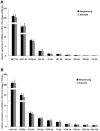Research resources: comparative microRNA profiles in human corona radiata cells and cumulus oophorus cells detected by next-generation small RNA sequencing
- PMID: 25188034
- PMCID: PMC4154750
- DOI: 10.1371/journal.pone.0106706
Research resources: comparative microRNA profiles in human corona radiata cells and cumulus oophorus cells detected by next-generation small RNA sequencing
Abstract
During folliculogenesis, cumulus cells surrounding the oocyte differentiate into corona radiata cells (CRCs) and cumulus oophorus cells (COCs), which are involved in gonadal steroidogenesis and the development of germ cells. Several studies suggested that microRNAs (miRNAs) play an important regulatory role at the post-transcriptional level in cumulus cells. However, comparative miRNA profiles and associated processes in human CRCs and COCs have not been reported before. In this study, miRNA profiles were obtained from CRCs and COCs using next generation sequencing in women undergoing controlled ovarian stimulation for IVF. A total of 785 and 799 annotated miRNAs were identified in CRCs and COCs, while high expression levels of six novel miRNAs were detected both in CRCs and in COCs. In addition, different expression patterns in CRCs and COCs were detected in 72 annotated miRNAs. To confirm the miRNA profile in COCs and CRCs, quantitative real-time PCR was used to validate the expression of annotated miRNAs, differentially expressed miRNAs, and novel miRNAs. The miRNAs in the let-7 family were found to be involved in the regulation of a broad range of biological processes in both cumulus cell populations, which was accompanied by a large amount of miRNA editing. Bioinformatics analysis showed that amino acid and energy metabolism were targeted significantly by miRNAs that were differentially expressed between CRCs and COCs. Our work extends the current knowledge of the regulatory role of miRNAs and their targeted pathways in folliculogenesis, and provides novel candidates for molecular biomarkers in the research of female infertility.
Conflict of interest statement
Figures





Similar articles
-
Age-related miRNome landscape of cumulus oophorus cells during controlled ovarian stimulation protocols in IVF cycles.Hum Reprod. 2021 Apr 20;36(5):1310-1325. doi: 10.1093/humrep/deaa364. Hum Reprod. 2021. PMID: 33454781 Free PMC article.
-
MicroRNA expression profile in bovine cumulus-oocyte complexes: possible role of let-7 and miR-106a in the development of bovine oocytes.Anim Reprod Sci. 2012 Jan;130(1-2):16-26. doi: 10.1016/j.anireprosci.2011.12.021. Epub 2012 Jan 10. Anim Reprod Sci. 2012. PMID: 22269106
-
MicroRNAs: new candidates for the regulation of the human cumulus-oocyte complex.Hum Reprod. 2013 Nov;28(11):3038-49. doi: 10.1093/humrep/det321. Epub 2013 Jul 30. Hum Reprod. 2013. PMID: 23904466
-
Failure to launch: aberrant cumulus gene expression during oocyte in vitro maturation.Reproduction. 2017 Mar;153(3):R109-R120. doi: 10.1530/REP-16-0426. Epub 2016 Nov 22. Reproduction. 2017. PMID: 27879344 Review.
-
Induction of oocyte maturation by hyaluronan-CD44 interaction in pigs.J Reprod Dev. 2010 Feb;56(1):15-9. doi: 10.1262/jrd.09-173e. J Reprod Dev. 2010. PMID: 20203431 Review.
Cited by
-
MicroRNA expression profile in chronic nonbacterial prostatitis revealed by next-generation small RNA sequencing.Asian J Androl. 2019 Jul-Aug;21(4):351-359. doi: 10.4103/aja.aja_97_18. Asian J Androl. 2019. PMID: 30604696 Free PMC article.
-
The Expression of miRNAs in Human Ovaries, Oocytes, Extracellular Vesicles, and Early Embryos: A Systematic Review.Cells. 2019 Dec 4;8(12):1564. doi: 10.3390/cells8121564. Cells. 2019. PMID: 31817143 Free PMC article.
-
MicroRNA-490-3p regulates cell proliferation and apoptosis in gastric cancer via direct targeting of AKT1.Exp Ther Med. 2019 Feb;17(2):1330-1336. doi: 10.3892/etm.2018.7042. Epub 2018 Dec 3. Exp Ther Med. 2019. PMID: 30680010 Free PMC article.
-
MicroRNA Expression Profile in Penile Cancer Revealed by Next-Generation Small RNA Sequencing.PLoS One. 2015 Jul 9;10(7):e0131336. doi: 10.1371/journal.pone.0131336. eCollection 2015. PLoS One. 2015. PMID: 26158897 Free PMC article.
-
MicroRNAs: From Female Fertility, Germ Cells, and Stem Cells to Cancer in Humans.Stem Cells Int. 2016;2016:3984937. doi: 10.1155/2016/3984937. Epub 2015 Nov 9. Stem Cells Int. 2016. PMID: 26664407 Free PMC article. Review.
References
-
- Oktem O, Oktay K (2008) The ovary: anatomy and function through-out human life. Ann N Y Acad Sci 1127: 1–9. - PubMed
-
- Imoedemhe DG, Sigue AB (1992) Survival of human oocytes cryopreserved with or without the cumulus in 1, 2-propanediol. J Assist Reprod Genet 9: 323–327. - PubMed
-
- Hussein TS, Froiland DA, Amato F, Thompson JG, Gilchrist RB (2005) Oocytes prevent cumulus cell apoptosis by maintaining a morphogenic paracrine gradient of bone morphogenetic proteins. J Cell Sci 118: 5257–5268. - PubMed
-
- Gregory L, Booth AD, Wells C, Walker SM (1994) A study of the cumulus-corona cell complex in in-vitro fertilization and embryo transfer; a prognostic indicator of the failure of implantation. Hum Reprod 9: 1308–1317. - PubMed
Publication types
MeSH terms
Substances
LinkOut - more resources
Full Text Sources
Other Literature Sources

